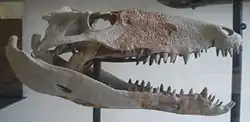Sebecidae
Sebecidae is an extinct family of prehistoric terrestrial sebecosuchian crocodylomorphs. The oldest known member of the group is Ogresuchus furatus known from the Upper Cretaceous (Maastrichtian) Tremp Formation (Spain).[1] Sebecids were diverse, abundant and broadly distributed in South America (mostly in Argentina, Brazil and Bolivia) during the Cenozoic, until the Middle Miocene;[2] although it has been suggested that at least some forms could have survived until the Miocene-Pliocene boundary in Brazil.[3]
| Sebecids | |
|---|---|
 | |
| Skull of Sebecus icaeorhinus | |
| Scientific classification | |
| Kingdom: | Animalia |
| Phylum: | Chordata |
| Class: | Reptilia |
| Clade: | †Sebecosuchia |
| Clade: | †Sebecia |
| Family: | †Sebecidae Simpson, 1937 |
| Subgroups | |
| Synonyms | |
| |
This group included many medium- and large-sized genera, from Sebecus to a giant indeterminate unnamed species from the Miocene.[4]
Phylogeny
The following cladogram simplified after Diego Pol and Jaime E. Powell (2011).[2]
| Sebecosuchia |
| ||||||||||||||||||||||||||||||||||||||||||||||||||||||||||||||||||||||||||||||
References
- Sellés, A. G.; Blanco, A.; Vila, B.; Marmi, J.; López-Soriano, F. J.; Llácer, S.; Frigola, J.; Canals, M.; Galobart, À. (2020). "A small Cretaceous crocodyliform in a dinosaur nesting ground and the origin of sebecids". Scientific Reports. 10 (1): Article number 15293. doi:10.1038/s41598-020-71975-y. PMID 32943663.
- Diego Pol and Jaime E. Powell (2011). "A new sebecid mesoeucrocodylian from the Rio Loro Formation (Palaeocene) of north-western Argentina". Zoological Journal of the Linnean Society. 163: S7–S36. doi:10.1111/j.1096-3642.2011.00714.x.
- Liccardo, Antonio, and Luiz Carlos Weinschütz. "Registro inédito de fósseis de vertebrados na Bacia Sedimentar de Curitiba (PR) Archived 2015-06-02 at the Wayback Machine." Revista Brasileira de Geociências 40.3 (2010): 330-338.
- Salias-Gismondi, R.; Antoine, P. O.; Baby, P.; Brusset, S.; Benammi, M.; Espurt, N.; de Franceschi, D.; Pujos, F.; et al. (2007). Middle Miocene Crocodiles From the Fitzcarrald Arch, Amazonian Peru (PDF). Instituto Geológical y Minero de España. p. 4. ISBN 978-84-7840-707-1. Archived from the original (PDF) on July 4, 2009. Retrieved May 12, 2010.
This article is issued from Wikipedia. The text is licensed under Creative Commons - Attribution - Sharealike. Additional terms may apply for the media files.

